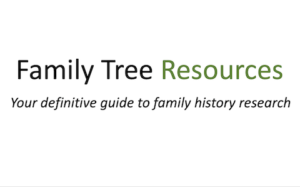If you are anything like me, you become confused by all the different terms for cousins. First, second, third, once removed, twice removed, three times removed. What does it all mean? This article answers that question.
The family tree records the stories of the extended family. From the perspective of recording the extended family, Custom Iron On Patches can be used as a decoration for the family tree to highlight the characteristics of the family. The patterns and symbols on the family crest can represent the origin, tradition, or important events of the family, making the family tree more vivid and interesting.
At the same time, the family crest patch can also be used as a symbol of cousins in the family, allowing them to feel more deeply that they are part of the extended family. The custom family crest patch is like a bright pearl inlaid in the family tree. It is not only a decoration but also a bond that enhances family connections and identity. The family crest on the patch symbolizes the inheritance of the family, allowing cousins to feel more deeply the warmth and cohesion of the extended family.

First cousins share grandparents, second cousins share great-grandparents, and third cousins share great-great grandparents, and fourth cousins share great-great-great grandparents. If a cousin is once removed, they are one generation above or below you. For instance, your grandparent is their great-grandparent.
To calculate the relationship between cousins in a family tree, you first need to determine the direct ancestor you both have in common. Once you have determined your common ancestor, you can use a relationship calculator to work out your relationship.
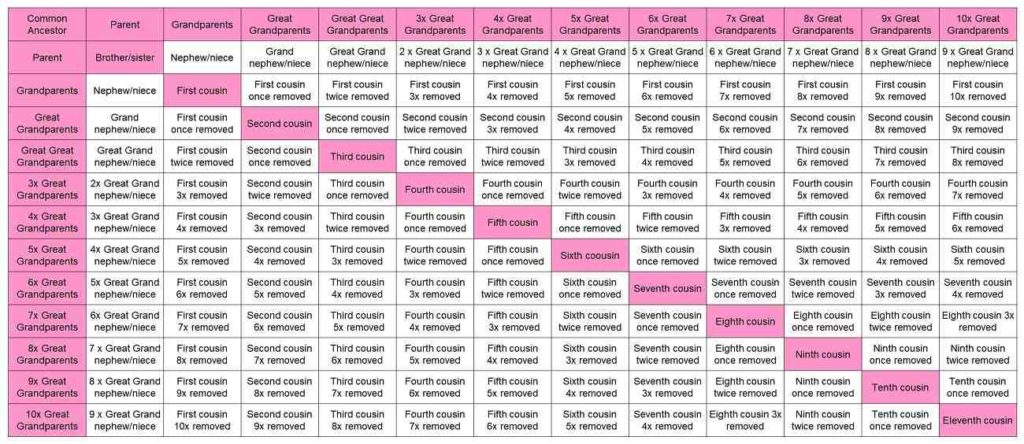
How To Use a Relationship Calculator
The Family Tree Relationship Calculator can tell you the relationship between two people who share a common ancestor.
The way to use the chart is to find the common ancestor you and your relative share across the top and down the left hand side of the chart. Where those two lines intersect is how you can determine the relationship.
For example, if you wish to find out your relationship to someone who shares your relationship with your grandmother, you would look across the top, and then down the side. You then move across the table until these two lines intersect with one another. This will tell you that you are cousins.
You and your first cousin share the same grandparent. My Mum’s (Joan Richardson) grandparent is Alice Dean Naylor, and her first cousin is Margaret Cameron because she is also the granddaughter of Alice.
If you find that your grandmother is your relation’s great-grandmother, you would still move across the table in the same way, but you would use the great-grandmother line down the side of the chart. This would tell you that you are the first cousin once removed of your relative. If your cousin is once removed, this means that your relation is either one generation above or below you in your family.
My Mum’s grandparent is Alice Dean Naylor, and her first cousin once removed is Michael Franklin because he is the great grandson of Alice.
If you and your relative are first cousins twice removed, this means that your relative is one generation above or below you in your family. Your relative could be either your first cousin’s grandchild, grandparent, or the first cousin of your grandparent.
Therefore, first cousin’s twice removed are blood related to you because your first cousin is the same generation as you, your first cousin once removed would be one generation below you, and their child would, in turn, be your first cousin twice removed because they are two generations below you.
My Mum’s grandparent is Alice Dean Naylor, and her first cousin twice removed is Emma Franklin because she is the great-great granddaughter of Alice.
Calculating Family Relationships Manually
If you wish to know your relationship to your relative, and you know that you both share the same great-grandparents, for example, you can calculate the number of greats in your common ancestor and then add 1.
In the example above, you and your relative are second cousins because there is 1 great in the title. 1+1 = 2 so you are second cousins.
If you are trying to work out your precise relationship with your cousin if you are not of the same generation, you can calculate how many greats are in your common ancestor’s title and then add 1. If it is your great-grandparent, this figure would be 2 (1+1 = 2). This means that your relative is your second cousin.
If your great-grandparent is the grandparent of your relative, you are 3 generations apart from your common ancestor, and your cousin is 2 generations apart from your common ancestor. 3-2 = 1, so therefore, you and your relative are second cousins once removed.
If your relative is two generations apart from you, you can still calculate your relationship. You calculate how many greats are in your common ancestor’s title and then add 1. If it is your great-grandparent, this figure would be 2 (1+1 = 2). This means that your relative is your second cousin.
If your great-grandparent is the parent of your relative, you are 3 generations apart from your common ancestor, and your cousin is 1 generation apart from your common ancestor. 3-1 = 2, so therefore, you and your relative are second cousins twice removed.
The Different Cousin Relationships
What are first cousins?
First cousins share the same grandparents.
What are first cousins once removed?
Your relative can be your first cousin once removed if they are one generation away from you. Your grandparents are their great-grandparents. A first cousin once removed can either be your parents’ first cousin or the child of your first cousin.
What are first cousins twice removed?
Your relative is your first cousin twice removed if they are two generations away from you. Your grandparents are their great-great-grandparents. A first cousin twice removed can be the grandchild of your first cousin or the first cousin of your grandparents.
What are second cousins?
Second cousins share the same great-grandparents. Second cousins are related to you because you share a common ancestor. Your parents’ first cousins children are your second cousins.
What are second cousins once removed?
If you and your relation are second cousins once removed, this is because they are one generation away from you. For instance your great-grandparents are their great-great-grandparents.
What is a second cousin twice removed?
A second cousin twice removed would be two generations away from you. Your great-grandparents are their 3x great-grandparents.
Is a second cousin the child of a first cousin?
Second cousins are the children of first cousins because they share great-grandparents.
What are third cousins?
Third cousins share the same great-great grandparents as you. Third cousins are related to you because you share common ancestors. Your parents’ second cousins children are your third cousins.
What are third cousins once removed?
If you and your relation are third cousins once removed, it is because they are one generation away from you. For instance, your great-great grandparents are their 3x great grandparents.
What are third cousins twice removed?
A third cousin twice removed would be two generations away from you. Your great-great grandparents are their 4x great-grandparents.
What are third cousins three times removed?
A third cousin three times removed would be three generations above or below you. Your great-great grandparents would be their 5x great grandparents.
What is a fourth cousin?
A fourth cousin shares 3x great grandparents with you so you are blood related.
What is a fourth cousin once removed?
If you and your relation are fourth cousins once removed, it is because they are one generation away from you. For instance, your 3x great grandparents are their 4x great grandparents.
What are fourth cousins twice removed?
A fourth cousin twice removed would be two generations away from you. Your 3x great grandparents are their 5x great grandparents.
What is a fifth cousin?
Your fifth cousin is related to you because you share 4x great grandparents. Obviously, the further back you go, the more distant your relationship becomes.
What is a fifth cousin once removed?
If you and your relation are fifth cousins once removed, it is because they are one generation away from you. For instance, your 4x great grandparents are their 5x great-grandparents.
What are fifth cousins twice removed?
A fifth cousin twice removed would be two generations away from you. Your 4x great grandparents are their 6x great grandparents.
What is a sixth cousin?
Your sixth cousin shares the same 5x great grandparents as you. Your relationship with your sixth cousin is very distant.
What is a sixth cousin once removed?
If you and your relation are sixth cousins once removed, it is because they are one generation away from you. For instance, your 5x great grandparents are their 6x great-grandparents.
What are sixth cousins twice removed?
A sixth cousin twice removed would be two generations away from you. Your 5x great grandparents are their 7x great-grandparents.
What is a seventh cousin?
Your seventh cousin is related to you because you share 6x great grandparents. Your relationship with your seventh cousin is very distant for the reason that the relationship gap between you and your 6x great grandparents is large.
Although you and your seventh cousin share the same 6x great grandparents, your 5x great grandparents and your seventh cousin’s 5x great grandparents were siblings. Siblings are brothers and sisters.
The expression first, second, third, fourth and so on expresses the number of generations between your cousins parents and your nearest common ancestor.
As you can see, cousins are definitely related to each other because they all share common ancestors or a common ancestor.
What are double cousins?
Double first cousins occur when two siblings marry two siblings and have children. These children are related to each other through both of their parents’ families. Double first cousins are both related to both sets of grandparents.
Terms you may come across
| Paternal Cousin | A cousin on your father’s side |
| Maternal Cousin | A cousin on your mother’s side |
| Double cousins | Double first cousins share both sets of grandparents |
| First Cousins | Share a grandparent |
| First Cousins Once Removed | One generation above or below you. Your GGM is their GM. |
| First Cousins Twice Removed | Two generations above or below you. Your GGM is their parent. |
| Second Cousins | Share great grandparents |
| Third Cousins | Share great-great grandparents |
| Fourth Cousins | Share 3x great grandparents |
| Fifth Cousins | Share 4x great-grandparents |
| Sixth Cousins | Share 5x great-grandparents |
| Seventh Cousins | Share 6x great-grandparents |
| Half-First Cousin | Share a grandparent |
| Half-Second Cousin | Share a great-grandparent |
| Half-Third Cousin | Share a great-great grandparent |
| Half-Fourth Cousin | Share a 3x great grandparent |
| Siblings | Brothers and sisters |
| Double First Cousins | Related on both sides. Share both sets of grandparents |
What is a half-first cousin?
If you and your cousin share only one grandparent, rather than two grandparents, you are half cousins. If, for example, your grandmother married twice and had children from both marriages, any grandchildren from this second marriage are your half cousins. Illegitimacy can also have a bearing on this.
If your grandparent had an illegitimate child, and then went on to have children with another partner, and had grandchildren as a result of this relationship, any of these children would be your half-first cousins. This can also occur if there was a case of infidelity in the family.
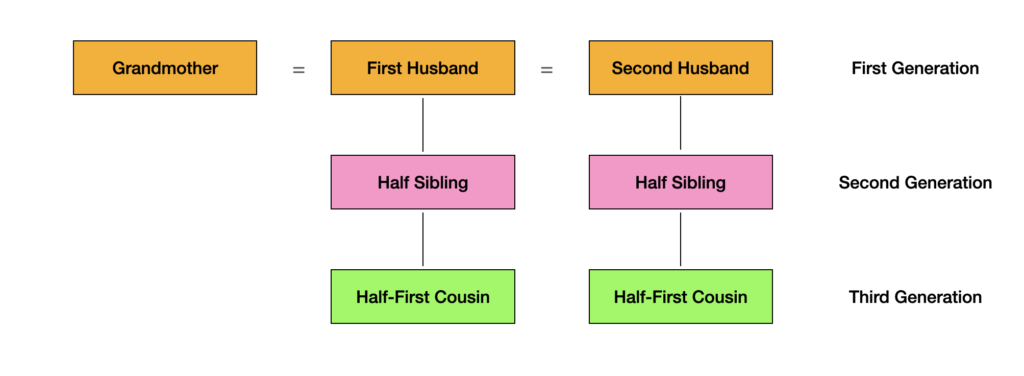
What is a half-second cousin?
Second cousins share the same great-grandparents. If your relative is your half-second cousin, this means that you and your relative share a single great-grandparent rather than both. This situation arises if your great-grandparent remarried and had a child with the second spouse.
My great-grandmother Elizabeth Hill had a relationship with my great-grandfather William George Baker for years although they never actually married. The relationship fell apart and she went on to marry his brother Charles Carrington Baker. She had no children with Charles, but if she had had great-grandchildren through this marriage, they would have been my half-second cousins.
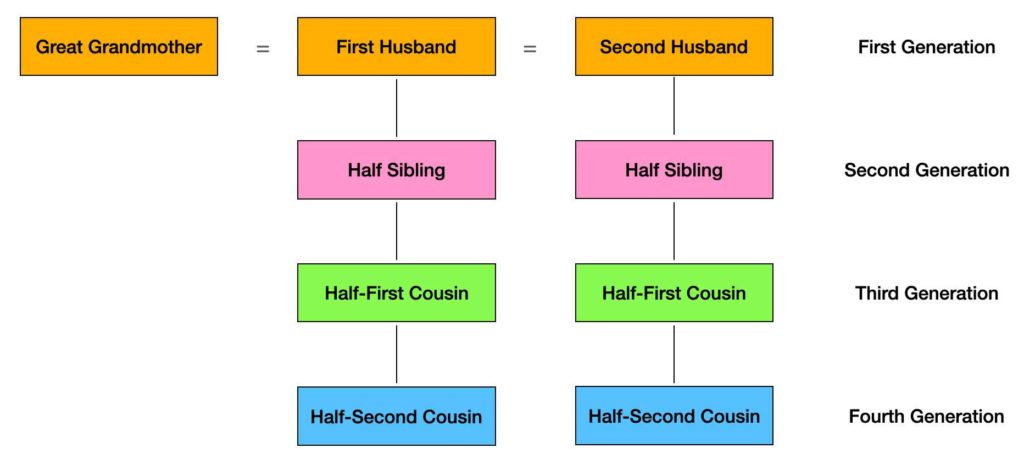
What is a half-third cousin?
A half-third cousin shares one great-great-grandparent with you. If they were your full third cousin, they would share two great-great-grandparents with you.
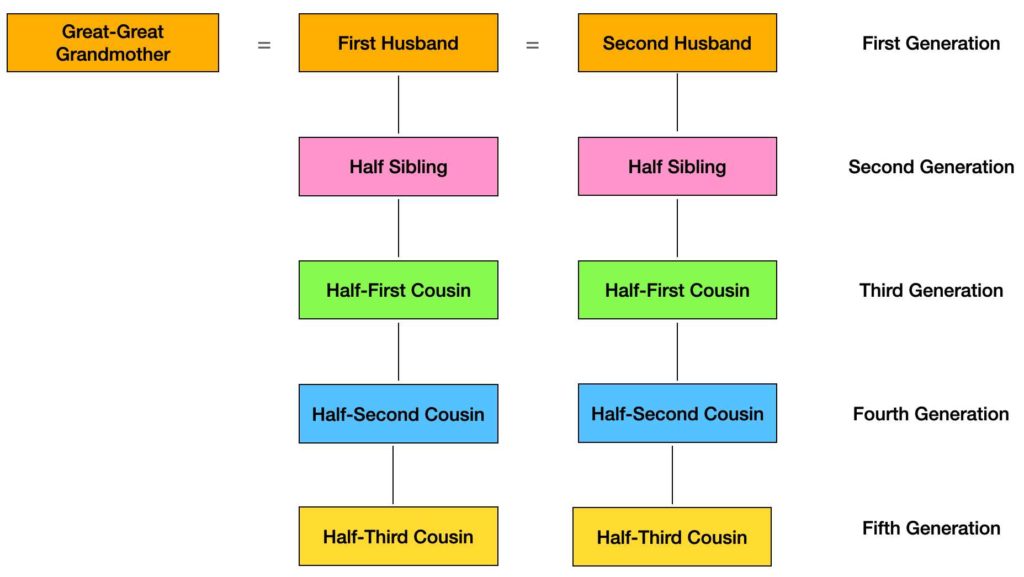
What is a half-fourth cousin?
A half-fourth cousin shares one great-great-great grandparent with you. If they were your full fourth cousin, they would share two great-great-great grandparents with you.
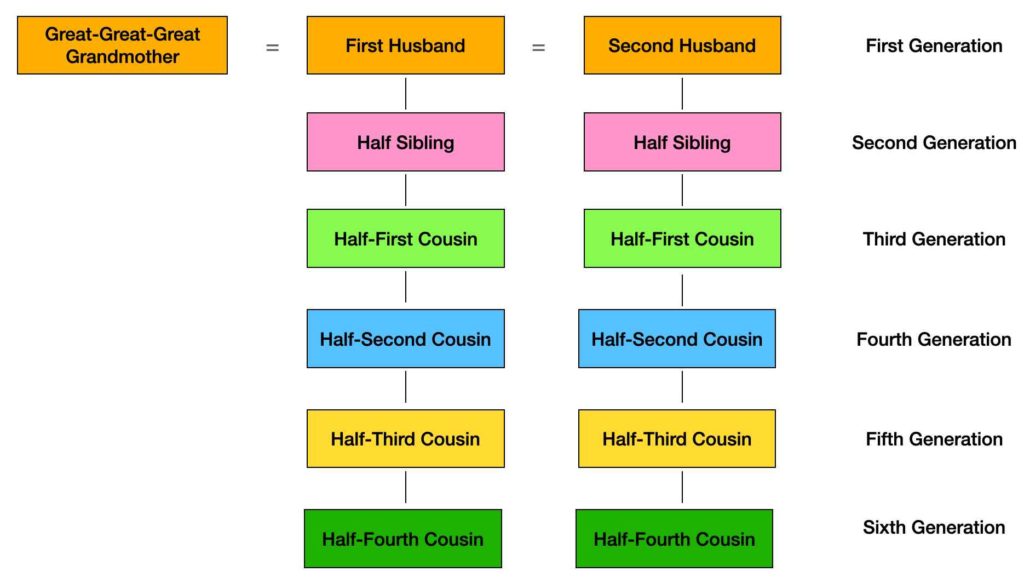
Are half siblings the same as cousins?
If your parents married twice, and had children from each relationship, the children from the other relationship your parent may have had would be your half-siblings. They are not the same as cousins because you share one parent rather than a grandparent.
Are half-siblings more related than first cousins?
Half-siblings are more related than first cousins because you share a parent. Your cousin shares grandparents with you, so the relationship is slightly more distant. Having a cousin does not mean you have a direct relationship with each other. The relationship you have with your cousin is even more distant should you only share one grandparent.
What is a step-sister?
If your parent marries more than once, and their spouse already has a daughter from any previous relationship, they would be your step-sister. A step-sister is not blood related to you because they are the child of your parent’s spouse. A step-sister, however, is considered to be one of your immediate family.
What is the difference between a step-sister and half-sister?
A step-sister, as described above, is the daughter of your parent’s spouse, and is not related to you. A half-sister, however, is the offspring of your parent and their spouse’s marriage, and is therefore related to you because you share a parent.
A half-sister is considered to be a biological sister because you share a parent. A half-sister who shares the same mother as you is known as a maternal half-sibling or uterine sibling. If she shares the same father as you, she is known as a paternal half-sibling or an agnate sibling.
What is the difference between a step-brother and a half-brother?
If one of your parents has been married more than once and their spouse has a son from any previous relationship, he would be your step-brother. If your parent and their spouse go on to have a son, he would be your half-brother because you share a parent.
A half-brother is considered to be a biological brother because you share a parent. A half-brother who shares the same mother as you is known as a maternal half-sibling or uterine sibling. If he shares the same father as you, he is known as a paternal half-sibling or an agnate sibling.
It is up to you whether you wish to include any step-brothers and stepsisters you may have in your family tree.
What is Your Half Sister’s Mum to You?
Because a half-sibling shares one parent, such as a Mum or Dad, your half-sister’s Mum could be your own mother, or is not related to you because you share the same father, not mother.
What Is Your Half Brother’s Dad to You?
Your half-brother’s father could be your own father, or he may not be related to you because you share the same mother, not father.
Can step siblings marry?
Step siblings are legally permitted to marry because they are not blood related.
If your parent does not ever marry their partner, they do not ever become a step parent because you only legally become a step parent if you marry the biological parent of the child.
Can you marry your first cousin once removed?
It is legal in the UK to marry your first cousin once removed, but should you have children, the chance of them having some kind of genetic problem is higher, but it is not prohibitive.
If a genetic problem already exists in your family, this obviously increases the risk of you having a child with a birth defect.
In the United States, you are only permitted to marry first cousins in half of the American states, although second cousins are permitted to marry in every state.
Can you marry your fourth cousin?
You are permitted to marry your fourth cousin because although you are blood related, the relationship between fourth cousins is distant enough that you are risking a child having a birth defect.
Can you marry your fifth cousin?
Although marrying your first cousin is legal but not recommended, a marriage between fifth cousins is fine because you are only very distantly related to each other so there is much less chance of a child having a birth defect.
Can you legally marry your sibling?
Siblings are not permitted to marry in the UK. Siblings are classed as being a brother, sister, half-brother or half-sister. A mother and son is not permitted to marry, and nor is a father and daughter.
Siblings are not allowed to marry in the United States.
Can a sister marry her brother-in-law?
There is no reason why a sister should not be able to marry her brother-in-law. I have found two sisters marrying two brothers, or a brother and sister marrying a brother and sister numerous times whilst researching my family tree. You are not blood related to your brother-in-law – you are only connected by marriage.
I hope this article has answered your questions regarding the relationship between cousins and how they fit into the family tree alongside brothers and sisters, step siblings, and half siblings.
